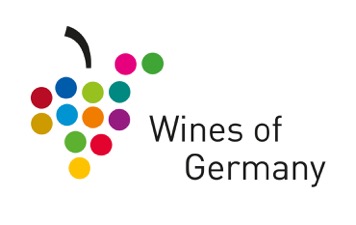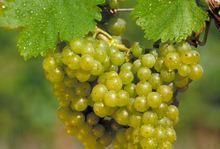Hvite tradisjonelle
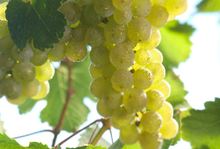
Riesling
Of all the grapes of Germany, the most noble is the Riesling — a variety that can do well even in stony soil and can subsist on a minimum of moisture.
It is also frost-resistant and a very dependable bearer of high quality grapes which have an acidity level that gives the wine a racy freshness and contributes to its long life. To reach its full potential, Riesling needs extra days of sun; ripening is very late, usually not until the latter half of October.
Riesling produces elegant wines of rich character with an incomparable fragrance and taste, often reminiscent of peaches, or when young, apples. In 1996, the vineyard area planted with Riesling exceeded that of Müller-Thurgau, thus making it Germany's premier grape variety in terms of area (ca. one fifth of all plantings). It is grown throughout German wine country.
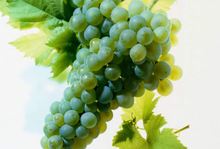
Müller-Thurgau / Rivaner
The Müller-Thurgau, or Rivaner, is the second most widely planted grape in Germany and accounts for about a fifth of the total vineyard area.
It is named after Professor Müller of Thurgau, Switzerland, who created it in 1882, by crossing Riesling and Gutedel not, as previously assumed, Riesling and Silvaner. It yields about 30% more than Riesling and ripens earlier, usually in the latter part of September. While it requires less sun and makes few demands of the climate, it does need more rain than Riesling, as well as soil with good drainage.
Its wines are generally light, with a flowery bouquet and less acidity than Riesling. Müller-Thurgau often carries a hint of Muscat in its flavor. The wines are best consumed while fresh and young. Dry versions are increasingly marketed under the synonym Rivaner. It is grown throughout German wine country.
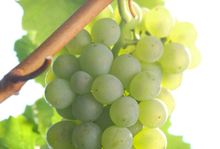
Silvaner
Silvaner is an old variety that once was the most important grape in Germany.
Today, it accounts for some 7% of the country's plantings. A reasonably abundant producer, it likes average exposure to the sunshine and needs moist soil. It ripens about two weeks earlier than Riesling.
Silvaner makes a rather full-bodied, neutral wine with a mild acidity, and is generally best enjoyed while young. A traditional variety in Franken, Rheinhessen and Saale-Unstrut, there are also extensive plantings in the Pfalz and an enclave in the Kaiserstuhl district of Baden.
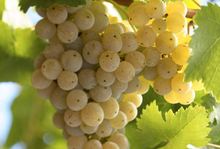
Kerner
Today, Kerner is the most widely planted new crossing in Germany, covering about 7% of the surface devoted to viticulture.
Bred in 1969 in Württemberg and named after a local poet, Justinius Kerner, it is a crossing of Trollinger and Riesling. Compared with Riesling, Kerner can be grown in less favorable sites and yields more.
It ripens in early October. The wines are fresh, racy and fruity — not unlike Riesling — yet milder in acidity, with a more pronounced bouquet, often with a Muscat tone. The largest vineyard areas of Kerner are in the Pfalz, Rheinhessen, Württemberg and Mosel-Saar-Ruwer regions.
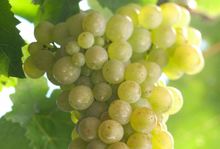
Weißer Burgunder
Synonymous with the French Pinot Blanc, this ancient variety thrives in fertile or chalky soils and ripens fairly late.
Weissburgunder wines have a less pronounced, relatively neutral bouquet, yet more acidity, than the Grauburgunder (from which it mutated).
The drier style wines are extremely popular with food. Most plantings are in Baden and the Pfalz, but it is also a traditional variety in the Saale-Unstrut and Sachsen regions.
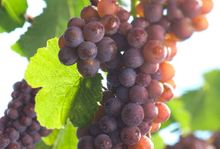
Grauer Burgunder
These are synonyms for the grape known as Pinot Gris in France and Pinot Grigio in Italy.
Grauburgunder denotes the more food-compatible, sleeker, drier style, while the richer, fuller-bodied and more fragrant version is labeled Ruländer. The latter is named after a businessman from Speyer, Johann Ruland, who propagated it in the early 18th century.
This variety needs good vineyards with deep, heavy soil. Harvest time is usually late September and early October. It is grown primarily in Baden and the Pfalz.
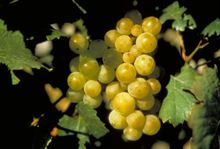
Bacchus
Bred in the Pfalz and given the Latin name for Dionysos, the Greek God of Wine, Bacchus is a crossing of (Silvaner x Riesling) x Müller-Thurgau.
It is a large yielder that, with sufficient ripeness, can produce fruity wines with a distinctive, aromatic bouquet and a light Muscat tone. Bacchus is grown primarily in the Pfalz, Rheinhessen, Franken and Nahe regions.
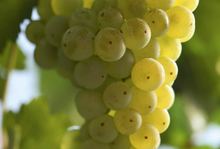
Scheurebe
Scheurebe (pronounced "shoy ray beh") is another new crossing that is well established in a number of regions.
Bred in 1916 in Rheinhessen and named after its breeder, Georg Scheu, it is a crossing of Silvaner and Riesling. It ripens in early October, but the late-harvested wines of this grape are those that are treasured most.
The wines have full body, pronounced acidity and a bouquet and taste reminiscent of black currants. Scheurebe is most widely planted in the Pfalz, Rheinhessen and Nahe regions.
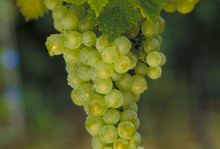
Gutedel
Known as Chasselas in France and Fendant in Switzerland, this ancient white variety is both a popular table grape and a wine grape.
It ripens fairly early and produces a rather neutral wine, low in acidity, that is best enjoyed while young. Gutedel probably originated in Asia Minor. German plantings today are almost exclusively limited to Baden's southernmost district, Markgräflerland.
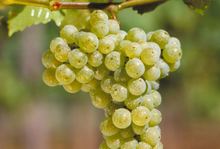
Farberrebe
The prolific Rheinhessen grape breeder Georg Scheu crossed Weissburgunder with Müller-Thurgau in 1929 to produce this early-ripening white variety.
With sufficient ripeness, the Faberrebe can produce elegant, refreshing wines with a light Muscat tone and, usually, more acidity than Müller-Thurgau or Silvaner. The majority of plantings are in the Rheinhessen, Pfalz and Nahe regions.
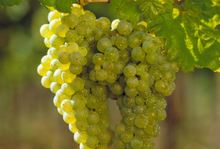
Huxelrebe
Huxelrebe, a crossing of Gutedel and Courtillier Musqué, was bred by Georg Scheu in Rheinhessen in 1927.
If left on its own, this white variety can achive record-breaking yields (and correspondingly lower-quality wine); however, if yields are controlled, the Huxelrebe can produce Auslese and dessert wines even in an average year.
Fully ripened Huxelrebe has a rich bouquet and flavor and, as its heritage implies, a refined Muscat tone. It is grown primarily in Rheinhessen and the Pfalz and to a small extent in the Nahe.
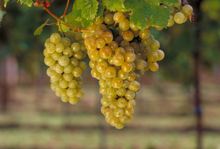
Ortega
This crossing of Müller-Thurgau and Siegerrebe is a very early-ripening white variety that achieves high must weights even in average years.
Ortega Auslese and dessert wines have a rich, peachy bouquet and flavor. Rheinhessen and the Pfalz have the most plantings, but it is also grown in the Mosel-Saar-Ruwer region as well as in Franken, where it was bred.
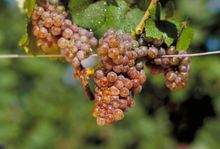
Gewürztraminer
Roter Traminer, and its better-known synonym, Gewürztraminer, or "spicy (aromatic) Traminer," is an old, traditional variety prized for the high quality of its wine.
From the Middle Ages until the 19th century, it was widely planted in central and eastern Europe. German plantings today are centered in the Obermosel district, that portion of the Mosel-Saar-Ruwer that is adjacent to Luxembourg.While it is frost-resistant, it does need warm vineyard sites and soil with good drainage. It begins to ripen about the end of September. Yields are quite variable (due to weather conditions) and as such, it is cultivated as a specialty rather than for its profitability.
Gewürztraminer wines have a distinctive, pronounced bouquet and flavor, often compared with lychees or roses. Even when vinified dry, German Gewürztraminer is usually less austere than its Alsatian counterpart. Sweeter versions have a loyal following here, too. It is a traditional grape of the Pfalz, but is also grown in Baden, where it is known as Clevner, and in Rheinhessen.

Elbling
This ancient white variety (origin unknown) is an early-ripening, very prolific producer that makes light, piquant wines that often are used for sparkling wine, thanks to their high acidity.
From the Middle Ages until the 19th century, it was widely planted in central and eastern Europe. German plantings today are centered in the Obermosel district, that portion of the Mosel-Saar-Ruwer that is adjacent to Luxembourg.
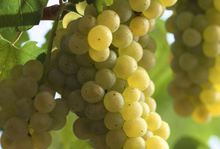
Chardonnay
Like many other ancient grape varieties, Chardonnay stems from the Middle East.
As viticulture spread, the variety found a new home in France, particularly in Burgundy. Chardonnay is one of the most popular grape varieties in the world. The cultivation of Chardonnay has been officially permitted in Germany since 1991. In the meantime, more than 600 ha (ca. 1,500 acres) have been planted and it accounts for 0.6% of Germany's total vineyard area.
A wide range of aromas are typical for Chardonnay, e.g. melons, exotic fruits, overripe gooseberries or slightly underripe apples. Higher qualities are usually rich in alcohol and extract. They are wines of substance, with a long finish, and often vinified in Barrique casks.
